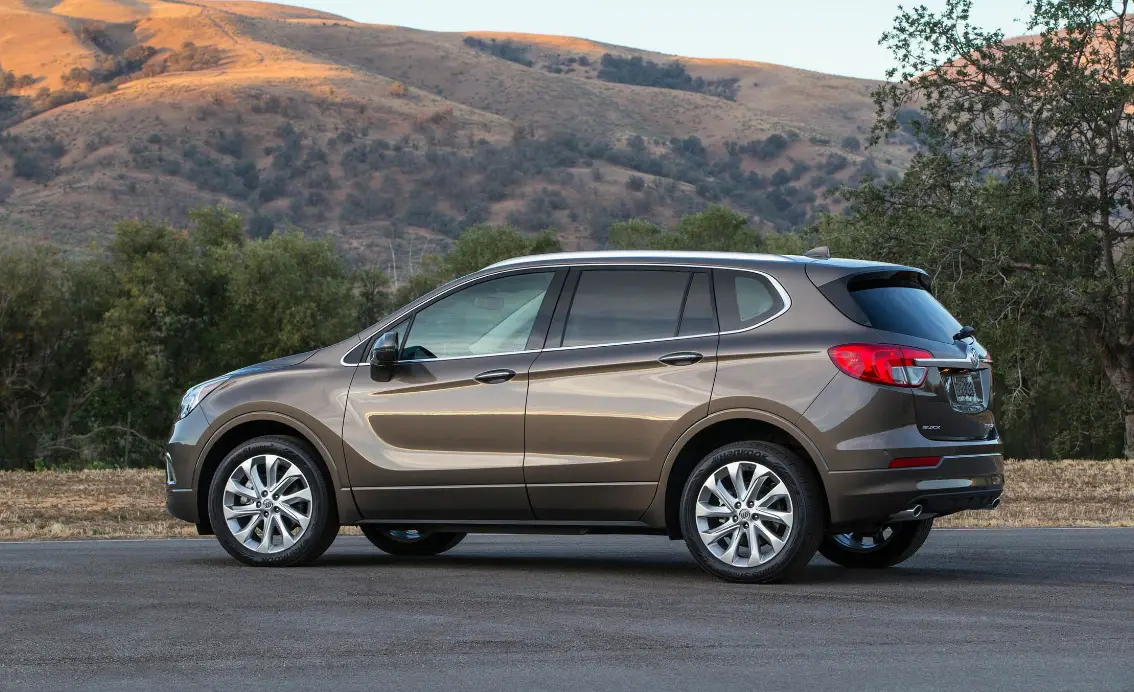Buick Envision 2018 User Manual
The 2018 Buick Envision is a small luxury SUV with a stylish look, a roomy cabin, and high-tech features. The Envision is a great car to drive thanks to its stylish appearance, comfortable interior, and cutting-edge technology. It can fit up to five people comfortably and has high-quality materials, leather upholstery, and a variety of features, such as heated and cooled chairs. The Envision keeps passengers informed and entertained with an easy-to-use infotainment system, smartphone integration, and optional features like a premium audio system and panoramic sunroof. Under the hood, you can choose from different engines, including one that is turbocharged, to get a good mix of power and fuel economy. With its focus on safety and driver-assistance features, the Envision is a great choice for people who want a reliable and luxurious small SUV.
Airbag System
The vehicle has the following airbags:
- A frontal airbag for the driver. A frontal airbag for the front outboard passenger
- A knee airbag for the driver
- A knee airbag for the front outboard passenger
- A seat-mounted side impact airbag for the driver
- A seat-mounted side impact airbag for the front outboard passenger
- Seat-mounted side impact airbags for the second-row outboard passengers
- A roof-rail airbag for the driver and the passenger seated directly behind the driver
- A roof-rail airbag for the front outboard passenger and the passenger seated directly behind the front outboard passenger
All vehicle airbags have the word AIRBAG on the trim or on a label near the deployment opening. For frontal airbags, the word
AIRBAG is on the center of the steering wheel for the driver and on the instrument panel for the front outboard passenger.
For knee airbags, the word AIRBAG is on the lower part of the instrument panel.
For seat-mounted side impact airbags, the word AIRBAG is on the side of the seatback closest to the door.
For roof-rail airbags, the word AIRBAG is on the ceiling or trim. Airbags are designed to supplement the protection provided by seat belts. Even though today’s airbags are also designed to help reduce the risk of injury from the force of an inflating bag, all airbags must inflate very quickly to do their job.
Here are the most important things to know about the airbag system:
Warning
You can be severely injured or killed in a crash if you are not wearing your seat belt, even with airbags. Airbags are designed to work with seat belts, not replace them. Also, airbags are not designed to inflate in every crash. In some crashes seat belts are the only restraint. See When Should an Airbag Inflate? 0 75.
Wearing your seat belt during a crash helps reduce your chance of hitting things inside the vehicle or being ejected from it. Airbags are “supplemental restraints” to the seat belts. Everyone in the vehicle should wear a seat belt properly, whether or not there is an airbag for that person.
Because airbags inflate with great force and faster than the blink of an eye, anyone who is up against, or very close to, any airbag when it inflates can be seriously injured or killed. Do not sit unnecessarily close to any airbag, as you would be if sitting on the edge of the seat or leaning forward. Seat belts help keep you in position before and during a crash. Always wear a seat belt, even with airbags. The driver should sit as far back as possible while still maintaining control of the vehicle. The seat belts and the front outboard passenger airbags are most effective when you are sitting well back and upright in the seat with both feet on the floor.
Occupants should not lean on or sleep against the door or side windows in seating positions with seat-mounted side impact airbags and/or roof-rail airbags.
Children who are up against, or very close to, any airbag, when it inflates, can be seriously injured or killed. Always secure children properly in the vehicle. To read how, see Older Children 0 84 or Infants and Young Children 0 86.
There is an airbag readiness light on the instrument cluster, which shows the airbag symbol. The system checks the airbag electrical system for malfunctions. The light tells you if there is an electrical problem. See Airbag Readiness Light 0 124
Where Are the Airbags?
The driver frontal airbag is in the center of the steering wheel.
The front outboard passenger frontal airbag is in the passenger side instrument panel.
The driver knee airbag is below the steering column. The front outboard passenger knee airbag is below the glove box.
The driver and front outboard passenger seat-mounted side impact airbags are in the side of the seatbacks closest to the door.
On vehicles with second-row seat-mounted side impact airbags, they are in the sides of the seatback closest to the door.
Driver Side Shown, Passenger Side Similar
The roof-rail airbags for the driver, front-outboard passenger, and second-row-outboard passengers are in the ceiling above the side windows.
Warning
If something is between an occupant and an airbag, the airbag might not inflate properly or it might force the object into that person causing severe injury or even death. The path of an inflating airbag must be kept clear. Do not put anything between an occupant and an airbag, and do not attach or put anything on the steering wheel hub or on or near any other airbag covering.
Do not use seat accessories that block the inflation path of a seat-mounted side impact airbag.
Never secure anything to the roof of a vehicle with roof-rail airbags by routing a rope or tie‐down through any door or window opening. If you do, the path of an inflating roof-rail airbag will be blocked.
When Should an Airbag Inflate?
This vehicle is equipped with airbags. See Airbag System 0 72.
Airbags are designed to inflate if the impact exceeds the specific airbag system’s deployment threshold.
Deployment thresholds are used to predict how severe a crash is likely to be in time for the airbags to inflate and help restrain the occupants. The vehicle has electronic sensors that help the airbag system determine the severity of the impact. Deployment thresholds can vary with specific vehicle design.
Frontal airbags are designed to inflate in moderate to severe frontal or near frontal crashes to help reduce the potential for severe injuries, mainly to the driver’s or front outboard passenger’s head and chest.
Whether the frontal airbags will or should inflate is not based primarily on how fast the vehicle is traveling.
It depends on what is hit, the direction of the impact, and how quickly the vehicle slows down.
Frontal airbags may inflate at different crash speeds depending on whether the vehicle hits an object straight on or at an angle, and whether the object is fixed or
moving, rigid or deformable, narrow or wide.
Frontal airbags are not intended to inflate during vehicle rollovers, rear impacts, or many side impacts.
In addition, the vehicle has advanced technology frontal airbags. Advanced technology frontal airbags adjust the restraint according to crash severity or occupant interaction.
The vehicle also has a seat position sensor that enables the sensing system to monitor the position of the front outboard passenger seat. The passenger seat position sensor and the passenger seat belt buckle provide information that is used to adjust the deployment of the front outboard passenger frontal airbag.
Knee airbags are designed to inflate in moderate to severe frontal or near frontal impacts. Knee airbags are not designed to inflate during vehicle rollovers, in rear impacts, or in many side impacts.
The passenger seat position sensor and the passenger seat belt buckle also provide information that is used to determine if the passenger knee airbag should inflate.
Seat-mounted side impact airbags are designed to inflate in moderate to severe side crashes depending on the location of the impact.
Seat-mounted side impact airbags are not designed to inflate in frontal impacts, near frontal impacts, rollovers, or rear impacts.
A seat-mounted side impact airbag is designed to inflate on the side of the vehicle that is struck.
Roof-rail airbags are designed to inflate in moderate to severe side crashes depending on the location of the impact. In addition, these roof-rail airbags are designed to inflate during a rollover or in a severe frontal impact. Roof-rail airbags are not designed to inflate in rear impacts. Both roof-rail airbags will inflate when either side of the vehicle is struck, if the system predicts that the vehicle is about to roll over on its side, or in a severe frontal impact.
In any particular crash, no one can say whether an airbag should have inflated simply because of the vehicle damage or the repair costs.
FAQ
A1: The Buick Envision 2018 is offered in several trim levels, including the base Envision, Preferred, Essence, Premium, and Premium II.
A2: The starting price of the Buick Envision 2018 varies depending on the trim level and optional features chosen. However, the base price typically falls within the range of $33,995 to $44,960.
A3: The Buick Envision 2018 offers approximately 26.9 cubic feet of cargo space behind the rear seats. Folding down the rear seats expands the cargo capacity to around 57.3 cubic feet.
A4: The Buick Envision 2018 comes with a choice of two engines. The base engine is a 2.5-liter four-cylinder producing 197 horsepower. An optional turbocharged 2.0-liter four-cylinder engine is also available, delivering 252 horsepower.
A5: Yes, the Buick Envision 2018 offers an available all-wheel drive system for enhanced traction and stability in various road conditions.
A6: The fuel efficiency of the Buick Envision 2018 varies depending on the engine and drivetrain. On average, it achieves around 22-29 MPG (miles per gallon) in combined city and highway driving.
A7: The Buick Envision 2018 comes equipped with various safety features, including a rearview camera, rear parking sensors, stability control, traction control, and a comprehensive airbag system. Additional safety options may include blind-spot monitoring, lane departure warning, forward collision alert, and adaptive cruise control.
A8: The Buick Envision 2018 offers a range of technology features, such as an infotainment system with a touchscreen display, Apple CarPlay, Android Auto, Bluetooth connectivity, USB ports, and available features like a premium audio system, navigation, and a wireless charging pad.
A9: Yes, the Buick Envision 2018 comes with a warranty package that includes a four-year/50,000-mile bumper-to-bumper limited warranty and a six-year/70,000-mile powertrain limited warranty.
A10: When properly equipped, the Buick Envision 2018 has a maximum towing capacity of up to 1,500 pounds, making it suitable for towing smaller trailers or lightweight recreational equipment.
A11: Yes, the Buick Envision 2018 offers an available panoramic sunroof as an option on higher trim levels.
A12: The Buick Envision 2018 offers a range of exterior color options, including but not limited to Summit White, Ebony Twilight Metallic, Bronze Alloy Metallic, Chili Red Metallic, and Midnight Amethyst Metallic.
A13: Yes, the Buick Envision 2018 offers several advanced driver-assistance features as optional upgrades. These may include blind-spot monitoring, lane departure warning, forward collision alert, automatic emergency braking, and adaptive cruise control.
A14: The Buick Envision 2018 comes standard with two rows of seating, accommodating up to five passengers. The front seats are typically adjustable for comfort, and options for features like heated and ventilated seats are available on higher trim levels.
A15: Yes, the Buick Envision 2018 features smartphone integration with Apple CarPlay and Android Auto compatibility. This allows users to seamlessly connect their smartphones to the infotainment system, accessing their phone’s apps, contacts, music, and navigation directly through the vehicle’s display.
2023 Buick Envision Specs, Price, Features, Mileage (Brochure)
Useful Link
Download Link: https://www.buick.com/support/vehicle/manuals-guides
Related Article
2024 Buick Envista Specs, Price, Features, Mileage and Review
2023 Buick Enclave Specs, Price, Features, Mileage (Brochure)
2023 Buick Encore Gx Specs, Price, Features, Mileage (Brochure)
2024 Buick Encore GX Specs, Price, Features, Mileage and Review


